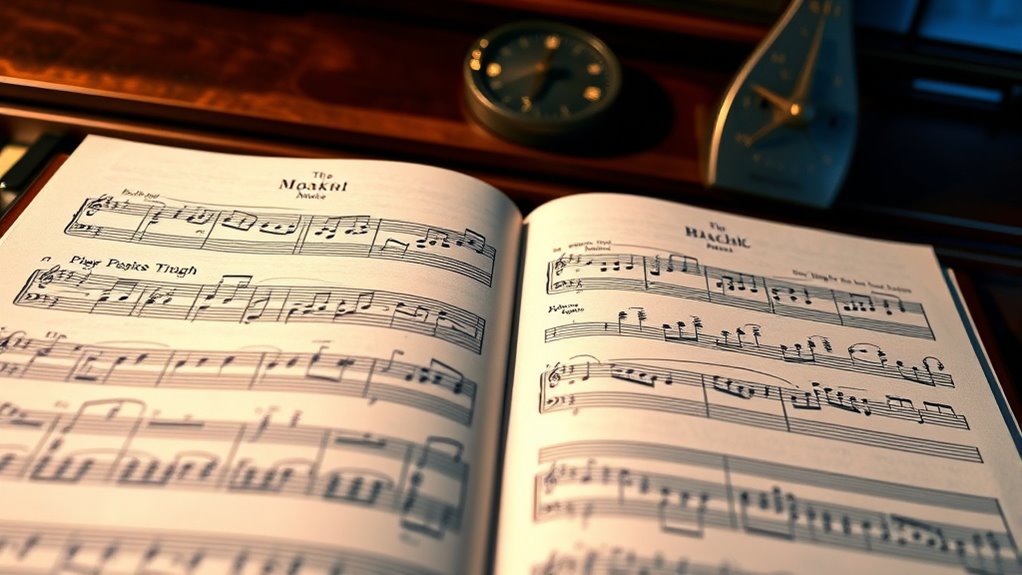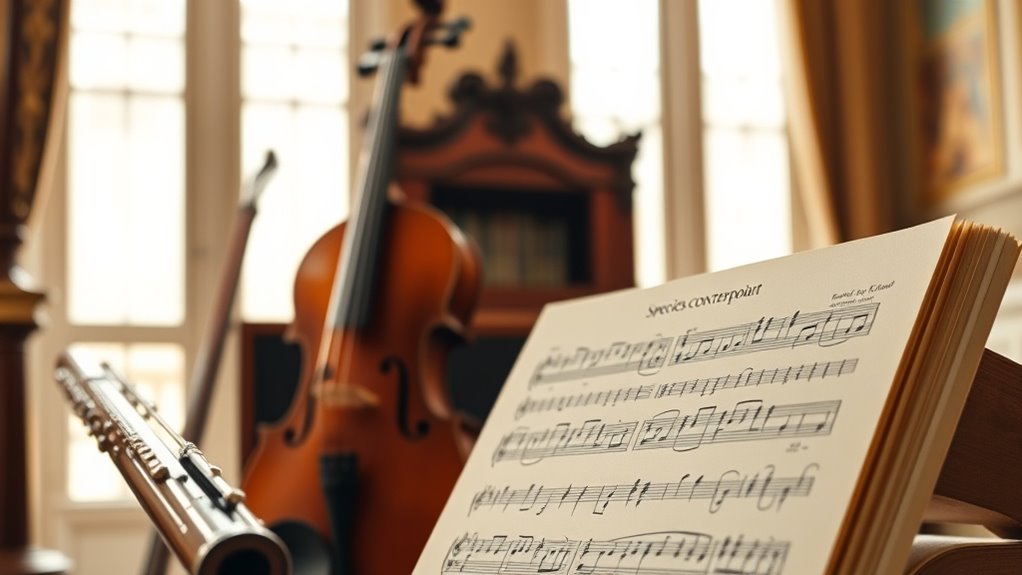To weave two melodies like Bach, focus on creating independent yet harmonically balanced lines. Use consonant intervals for stability and dissonances carefully for tension, resolving smoothly. Follow counterpoint rules, starting simple with species techniques, emphasizing proper voice leading, and avoiding parallel motion. Study Bach’s compositions to see these principles in action. Keep practicing by balancing melodic independence with harmonic coherence—if you continue, you’ll uncover deeper techniques and tips for mastering counterpoint.
Key Takeaways
- Focus on creating independent melodies that complement each other harmonically and rhythmically, maintaining voice independence.
- Use consonant intervals for stability and dissonances for tension, resolving them smoothly to achieve emotional expressiveness.
- Apply the species approach—start with first species (note-against-note) before progressing to second species with rhythmic variety.
- Employ voice leading techniques like contrary motion, common tones, and stepwise movement to ensure seamless melodic transitions.
- Analyze Bach’s counterpoint to learn effective motif development, balance, and blending of multiple melodic lines.
Understanding the Foundations of Counterpoint

Have you ever wondered what makes counterpoint so compelling in music? It all starts with understanding its foundations. Counterpoint involves combining two or more independent melodies that complement each other harmonically and rhythmically. To do this effectively, you need to grasp the concept of voice independence, where each melody maintains its own character while fitting seamlessly with others. You also need to pay attention to consonance and dissonance, ensuring that notes sound harmonious or intentionally tensioned, respectively. These principles help create balance and interest in your composition. Mastering counterpoint requires discipline in voice leading, making sure each melody moves smoothly and logically from note to note. Additionally, choosing suitable names for your musical motifs can enhance their memorability and character, much like selecting the perfect dog names for a pet. Understanding the importance of contrast and balance in musical textures is essential for creating engaging compositions. Exploring musical texture further can deepen your grasp of how different melodic lines interact to produce rich soundscapes. By understanding these core ideas, you’ll develop the skills to craft intricate, engaging musical lines.
The Basics of Melody and Harmony Interplay

Understanding how melody and harmony interact is essential for creating compelling counterpoint. You need to grasp how a melody stands out while supporting the harmony underneath. A strong melody often follows a clear shape, guiding listeners through tension and release, while harmony provides a stable foundation or adds richness. When you combine them, the melody should complement the harmony, emphasizing chord tones and avoiding dissonance unless intentionally used. Conversely, harmony should enhance the melody without overpowering it. Balancing these elements requires careful attention to intervals, chord progressions, and voice leading. By mastering this interplay, you’ll craft music where melodies weave seamlessly through harmonic textures, creating depth and interest—key to writing authentic counterpoint like Bach.
Exploring Consonance and Dissonance

You’ll notice how certain intervals sound stable and pleasing, while others create tension. Understanding the balance between consonance and dissonance is key to shaping musical expression. By exploring how tension resolves, you can craft more compelling counterpoint lines. Incorporating techniques like harmonic balance can help in creating a more engaging musical narrative. Additionally, recognizing how vibrational energy influences emotional responses can deepen your understanding of musical resonance. Applying principles from natural techniques in music composition can also enhance the organic flow of your melodies. Recognizing the influence of fatherly guidance and support on emotional depth can further enrich your musical storytelling.
Harmonious Intervals Explored
Harmonious intervals lie at the core of musical expression, shaping how you perceive stability and tension in a piece. When two notes blend smoothly, creating a sense of rest, you’re experiencing consonance. Perfect fifths and thirds are prime examples, offering a feeling of completeness. Dissonant intervals, like seconds and sevenths, create tension and a desire for resolution. These intervals challenge your ear, prompting movement toward more stable sounds. Understanding the balance between consonance and dissonance allows you to craft melodies that evoke emotion and keep listeners engaged. Recognizing how these intervals interact helps you build musical phrases that flow naturally, guiding your audience through moments of peace and anticipation. Mastering this interplay is essential for creating compelling counterpoint. Harmonic relationships play a crucial role in shaping emotional responses within melodies.
Tension and Release
Tension and release are fundamental to creating emotional impact in music, and this balance hinges on the interplay between consonance and dissonance. When you introduce dissonant intervals, you build tension that feels unstable or unresolved. To create release, you resolve these dissonances into consonant intervals, which sound stable and satisfying. In counterpoint, this push and pull guide your melodies, making them more engaging. You might delay resolving a dissonance to heighten anticipation or resolve it quickly for a sense of closure. Understanding how to manipulate tension helps you craft phrases that evoke emotion. By carefully balancing dissonance and consonance, you shape your music’s narrative, making it feel dynamic, expressive, and compelling. Additionally, experimenting with various musical techniques can deepen your understanding of tension and release, enhancing your compositional skills.
Types of Counterpoint: Species Approach

You’ll learn how the species approach breaks counterpoint into manageable stages, starting with First Species, which focuses on note-against-note harmony. As you progress, Second Species introduces rhythmic variety with half notes and suspensions. Understanding these variations helps you build solid counterpoint skills step by step. Additionally, mastering proper investment regulation and choosing the right storage options are essential for maintaining the integrity of your Gold IRA investments. Incorporating musical context into your practice can further deepen your understanding of how these species relate to overall compositional techniques. Proper technique ensures accurate application of each species and enhances your overall compositional mastery. Recognizing musical terminology can also assist in accurately analyzing and applying these species in your compositions.
First Species Technique
The First Species technique, also known as note against note, is the simplest and most fundamental approach to species counterpoint. In this method, you write one note in the counterpoint for every note in the cantus firmus, creating a straightforward, rhythmic dialogue between the two voices. Your goal is to guarantee smooth, consonant intervals—such as thirds, sixths, or perfect fifths and octaves—while avoiding dissonances. You’ll focus on proper voice leading, making sure each note moves logically and smoothly from one to the next. This approach emphasizes clarity and stability, providing a solid foundation for more complex counterpoint techniques. Mastering First Species helps you develop an ear for consonance, voice independence, and the basic rules that underpin all counterpoint writing.
Second Species Variations
Building on First Species, Second Species introduces a rhythmic variation by adding a new note between each main note of the cantus firmus, creating a more intricate melodic line. This approach emphasizes both consonances and controlled dissonances, which resolve smoothly. You’ll focus on echoing the rhythm while maintaining melodic independence. To help visualize, consider this table:
| Dissonance Placement | Resolution Timing |
|---|---|
| On a strong beat | Resolve to a consonant |
| Between beats | Resolve on the next beat |
| Dissonance notes | Must be passing or neighbor tones |
This variation demands careful attention to voice movement, ensuring dissonances are brief and properly resolved. Mastering Second Species helps develop your sense of rhythm, voice independence, and melodic balance. Incorporating counterpoint techniques is essential for creating harmonious and engaging melodies within this style. Additionally, understanding voice leading can greatly improve the precision and flow of your compositions, making your melodies more compelling. Developing a strong foundation in melodic control is crucial for executing these techniques effectively. Recognizing counterpoint techniques is essential for creating harmonious and engaging melodies within this style.
Crafting Complementary Voices

Creating complementary voices involves carefully tailoring each part of your counterpoint to enhance the overall harmony. You want each voice to support and contrast with the other, creating a balanced, engaging texture. Focus on maintaining proper intervals—like thirds, sixths, and perfect fifths—that sound stable and pleasing. Avoid overly similar lines that can muddy the texture, and steer clear of dissonances that aren’t resolved. Use rhythmic variety so each voice remains lively without overpowering the other. Think about how each melody interacts: one might outline a clear contour while the other provides harmonic support. Adjust note lengths and pitches thoughtfully, ensuring the voices work together naturally. Incorporating musical terminology can help refine your composition and achieve a more authentic Bach-like style. Crafting these voices with intention results in a rich, cohesive counterpoint that echoes the style of Bach.
Voice Leading Techniques for Smooth Transitions

Effective voice leading guarantees smooth, natural movement between chords and melodic lines in your counterpoint. To achieve this, focus on minimizing awkward leaps and emphasizing stepwise motion.
Smooth voice leading ensures natural, flowing movement in your counterpoint by minimizing leaps and emphasizing stepwise motion.
Here are three essential techniques:
- Common Tones — Keep the same note in consecutive chords to create seamless progressions.
- Stepwise Motion — Move by small intervals, like seconds or thirds, to maintain fluidity.
- Contrary Motion — Use opposite directions in voices to avoid parallel movement and add interest.
Analyzing Bach’s Counterpoint Masterpieces

Bach’s counterpoint masterpieces exemplify the art of balancing complexity with clarity, showcasing how intricate voice interactions can produce harmonious and engaging music. When analyzing these works, focus on how each voice maintains its independence while contributing to the overall structure. Observe how Bach employs motifs and thematic development to create coherence across the piece. Pay attention to the use of dissonance and resolution, which adds tension and release, guiding your ear smoothly through the music. Notice the contrapuntal techniques, such as imitation and inversion, that Bach expertly weaves together. By studying these elements, you’ll gain insight into how he orchestrates multiple melodies without sacrificing clarity, allowing you to better understand and emulate his mastery in your own compositions.
Practical Exercises to Develop Your Skills

To develop your counterpoint skills, engaging in targeted practical exercises is essential. These exercises help you internalize the principles of voice independence, melodic contrast, and harmonic balance. Start by writing simple two-voice melodies, focusing on maintaining clear melodic lines and avoiding parallel motion. Next, practice counterpoint by harmonizing a given melody, experimenting with different intervals and voice movements. Finally, analyze and rewrite Bach’s short fugues or inventions, noting how each voice interacts. These activities sharpen your ear for voice independence, improve your melodic writing, and deepen your understanding of harmonic relationships. Consistent practice with these exercises will steadily enhance your ability to craft balanced, engaging counterpoint in your compositions.
Tips for Creating Harmonically Rich Compositions

What strategies can you use to create compositions that sound harmonically rich and engaging? First, incorporate a variety of chord progressions, mixing major, minor, and modal chords to add color. Experiment with non-diatonic chords and secondary dominants to introduce surprising shifts. Use voice leading thoughtfully—smoothly connect notes to create seamless connection between chords. Layer melodies over harmonic textures, allowing your counterpoint to complement the harmony rather than compete with it. Add passing tones and suspensions to create tension and release within your progressions. Dynamic voicing and inversion choices also impact harmonic complexity. Remember, balancing familiarity with inventive chords keeps listeners engaged while maintaining coherence, resulting in a rich, vibrant harmonic landscape in your compositions.
Frequently Asked Questions
How Can Modern Composers Incorporate Counterpoint Into Contemporary Music?
You can incorporate counterpoint into contemporary music by experimenting with intertwining melodies that complement each other, creating harmony and contrast. Use modern instruments and digital tools to craft intricate lines, balancing complexity with simplicity. Embrace different styles, blending classical techniques with genres like pop, jazz, or electronic music. By listening to how melodies interact, you’ll develop your own voice while paying homage to traditional counterpoint, enriching your compositions.
What Are Common Mistakes to Avoid When Composing Counterpoint?
Ever wondered what pitfalls can ruin your counterpoint composition? You should avoid parallel motion, which weakens independence between melodies, and inconsistent voice leading, causing awkward passages. Don’t neglect maintaining clear harmonic functions, as muddled progressions confuse listeners. Remember, overcomplicating textures can clutter your piece; simplicity often shines. Keep melodies distinct, voices balanced, and connections smooth. By steering clear of these mistakes, your counterpoint will sound more polished and engaging.
How Does Counterpoint Influence Emotional Expression in Music?
Counterpoint greatly influences emotional expression by creating interplay between melodies that evokes feelings like tension, joy, or serenity. As you craft parts that complement or contrast, you’re shaping the listener’s emotional journey. You can heighten drama through dissonances or soothe with consonance. By skillfully weaving melodies, you deepen the music’s emotional impact, making the listener feel connected and engaged with the nuanced dialogue between your voices.
Are There Specific Genres Where Counterpoint Is More Prevalent?
Imagine music as a lively garden where different melodies are vibrant flowers blooming together. In genres like Baroque, Renaissance, and fugues, counterpoint is the gardener expertly weaving these flowers into intricate patterns. You’ll find it thriving in classical compositions, jazz improvisations, and even some folk tunes. These genres cherish the art of weaving melodies, creating rich textures that captivate and enchant listeners, much like a beautifully tended garden.
Can Beginners Learn Counterpoint Without Prior Music Theory Knowledge?
You can definitely start learning counterpoint without much prior music theory. Begin with simple exercises and focus on listening carefully to how melodies interact. Use beginner-friendly resources that break down the basics step-by-step. Practice by creating simple two-voice compositions, paying attention to consonance and dissonance. With patience and consistent practice, you’ll develop an understanding of counterpoint, even if you’re new to music theory.
Conclusion
Mastering counterpoint is like weaving a intricate tapestry of sound; each thread must balance and complement the others. As you practice the techniques and analyze Bach’s masterpieces, you’ll start to see how melodies intertwine seamlessly, creating harmony out of complexity. Keep experimenting and refining your skills, and you’ll craft compositions that resonate with the richness and depth of the great masters. With patience and dedication, you’ll transform your melodies into timeless musical conversations.









